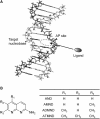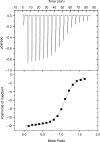Influence of substituent modifications on the binding of 2-amino-1,8-naphthyridines to cytosine opposite an AP site in DNA duplexes: thermodynamic characterization
- PMID: 19136458
- PMCID: PMC2655693
- DOI: 10.1093/nar/gkn1079
Influence of substituent modifications on the binding of 2-amino-1,8-naphthyridines to cytosine opposite an AP site in DNA duplexes: thermodynamic characterization
Abstract
Here, we report on a significant effect of substitutions on the binding affinity of a series of 2-amino-1,8-naphthyridines, i.e., 2-amino-1,8-naphthyridine (AND), 2-amino-7-methyl-1,8-naphthyridine (AMND), 2-amino-5,7-dimethyl-1,8-naphthyridine (ADMND) and 2-amino-5,6,7-trimethyl-1,8-naphthyridine (ATMND), all of which can bind to cytosine opposite an AP site in DNA duplexes. Fluorescence titration experiments show that the binding affinity for cytosine is effectively enhanced by the introduction of methyl groups to the naphthyridine ring, and the 1:1 binding constant (10(6) M(-1)) follows in the order of AND (0.30) < AMND (2.7) < ADMND (6.1) < ATMND (19) in solutions containing 110 mM Na(+) (pH 7.0, at 20 degrees C). The thermodynamic parameters obtained by isothermal titration calorimetry experiments indicate that the introduction of methyl groups effectively reduces the loss of binding entropy, which is indeed responsible for the increase in the binding affinity. The heat capacity change (DeltaC(p)), as determined from temperature dependence of the binding enthalpy, is found to be significantly different between AND (-161 cal/mol K) and ATMND (-217 cal/mol K). The hydrophobic contribution appears to be a key force to explain the observed effect of substitutions on the binding affinity when the observed binding free energy (DeltaG(obs)) is dissected into its component terms.
Figures








Similar articles
-
Thermodynamic characterization of the binding of naphthyridines to the AP site-containing DNA duplexes.Nucleic Acids Symp Ser (Oxf). 2006;(50):219-20. doi: 10.1093/nass/nrl109. Nucleic Acids Symp Ser (Oxf). 2006. PMID: 17150896
-
Strong binding of naphthyridine derivatives to cytosine in an AP site-containing DNA duplex and their application to fluorescence detection of single nucleotide polymorphisms.Nucleic Acids Symp Ser (Oxf). 2007;(51):313-4. doi: 10.1093/nass/nrm157. Nucleic Acids Symp Ser (Oxf). 2007. PMID: 18029712
-
Effect of an alkyl amino group on the binding of 1,8-naphthyridines to AP site-containing DNA duplexes.Nucleic Acids Symp Ser (Oxf). 2008;(52):117-8. doi: 10.1093/nass/nrn060. Nucleic Acids Symp Ser (Oxf). 2008. PMID: 18776281
-
Competitive binding of small ligands to nucleobases in AP site-containing DNA duplexes.Nucleic Acids Symp Ser (Oxf). 2008;(52):119-20. doi: 10.1093/nass/nrn061. Nucleic Acids Symp Ser (Oxf). 2008. PMID: 18776282
-
Competitive binding of abasic site-binding ligands and masking ligands to DNA duplexes for the analysis of single-base mutation.Anal Sci. 2013;29(1):15-9. doi: 10.2116/analsci.29.15. Anal Sci. 2013. PMID: 23303078
Cited by
-
Shape-selective recognition of DNA abasic sites by metallohelices: inhibition of human AP endonuclease 1.Nucleic Acids Res. 2015 Jun 23;43(11):5297-306. doi: 10.1093/nar/gkv438. Epub 2015 May 4. Nucleic Acids Res. 2015. PMID: 25940617 Free PMC article.
-
In vitro selection of shape-changing DNA nanostructures capable of binding-induced cargo release.ACS Nano. 2013 Nov 26;7(11):9675-83. doi: 10.1021/nn404079v. Epub 2013 Nov 4. ACS Nano. 2013. PMID: 24168267 Free PMC article.
-
Structure-Binding Relationship of 2-Amino-1,8-Naphthyridine Dimers: Role of Linkage Positions on DNA and RNA Recognition.Chemistry. 2025 May 19;31(28):e202500425. doi: 10.1002/chem.202500425. Epub 2025 Apr 10. Chemistry. 2025. PMID: 40207738 Free PMC article.
-
Synthesis of 1,8-naphthyridines and their application in the development of anionic fluorogenic chemosensors.J Fluoresc. 2012 Jul;22(4):1033-46. doi: 10.1007/s10895-012-1041-5. Epub 2012 Mar 27. J Fluoresc. 2012. PMID: 22450726
-
Engineering base-excised aptamers for highly specific recognition of adenosine.Chem Sci. 2020 Feb 10;11(10):2735-2743. doi: 10.1039/d0sc00086h. Chem Sci. 2020. PMID: 34084332 Free PMC article.
References
-
- Gottesfeld JM, Neely L, Trauger JW, Baird EE, Dervan PB. Regulation of gene expression by small molecules. Nature. 1997;387:202–205. - PubMed
-
- Dervan PB. Molecular recognition of DNA by small molecules. Bioorg. Med. Chem. 2001;9:2215–2235. - PubMed
-
- Spring DR. Chemical genetics to chemical genomics: small molecules offer big insghts. Chem. Soc. Rev. 2005;34:472–482. - PubMed
-
- Gewirtz DA. A critical evaluation of the mechanisms of action proposed for the antitumor effects of the anthracycline antibiotics adriamycin and daunorubicin. Biochem. Pharmacol. 1999;57:727–741. - PubMed

